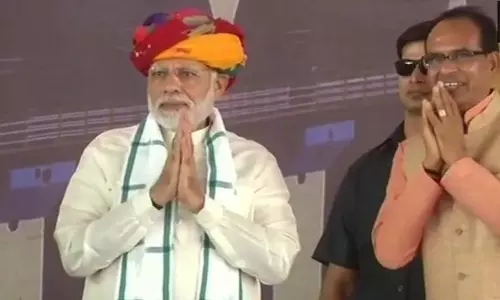
Political lessons of popular will
text_fieldsThe results of assembly elections in Maharashtra and Haryana are rich with lessons in the peculiar political situaton of contemporary India. In both states, the results have clearly reflected the popular anger against the anti-people fascist policies of BJP's central government and governments of the two states.
Although BJP has been assured continuity of its rule in both states, the national leadership of BJP and NDA are hardly likely to be happy with this lack-lustre victory. The BJP-Shiv Sena coalition that came to power in 2014 in Maharashtra with a landslide majority of 230 out of 288 seats, have this time finished with 29 fewer seats. On the other hand, the Opposition NCP-Congress alliance won 21 more seats taking its strength to 98. In Haryana, BJP allinace which had 70 out of 90 seats earlier, has now come to an unenviable position of having to depend on the support of independents for a majority. Congress has made a big leap winning 31 seats in Haryana. In both the states, political circumstances were in favour of BJP, with the Opposition parties far from being vibrant. In Maharashtra, barring the election rallies of Sharad Pawar, the contribution from Congress by way of poll preparation was negligible. It was no different in Haryana. Leaders including Rahul Gandhi made their presence felt only for a few days. Add to it the headache created by the faction fight in the party. Exit polls also forecast an easy walkover for BJP. But when the machines were unsealed, things turned out to be different.
Then the question arises as to what led the people to take into confidence a Congress party with all its inherent frailties and which indulged in internal dissensions thus fallng short of making suficient campaign programme. The plank that BJP tried to build on in the election propaganda in Maharashtra and Haryana, was the same that it used during the Lok Sabha election, i.e. the recipe of frenzied nationalism and communalsm. The campaigns were personally led by prime minister Narendra Modi and BJP's president and home minister Amit Shah. And this was the first poll held after the dilution of Article 370 which gave special privileges to Kashmir. Thus naturally Kashmir became the main theme during the election. Along with that, the diplomatic issues with Pakistan, Babri Masjid, triple talaq, uniform civil code and the NRC in Assam became campaign topics. A promise to confer Bharat Ratna postuhumously on Savarkar, who was an accused in the Gandhi assassinaton case, also was heard from Maharashtra. Ultimately, all this campaign had the trappings of a prelude to a package of alienating the minorities and embracing the majority community to make the country a political platform of Hindutva. Through such a high-pitched propaganda, the coalition was also able to skillfully sideline the burning issues faced by the country such as economic crisis and unemployment. But the factors like inequality and poverty,that were covered up in the electoral round, found expression clearly through the ballot. It is noteworthy that BJP suffered more loss of votes in Vidarbha and the western region of the state which suffered serious damage from flood and drought. And Maharashtra is the state with the highest GDP in the country and therefore the first to be hit by any economic crisis. As for Haryana, it is the state with the maximum number of automobile manufacturing units. That is the sector with tales of huge job losses. It is the Hindutva's devious design to conceal all such issues through the rhetoric of hyper-nationalism, but that has been totally rejected by the people. The fact that nine ministers in Maharashtra and seven in Haryana were defeated, speaks well for the depth of popular rage. This is visible also in others states including Gujarat where bypolls were held.
Hindutva politics should by now have realised that it will be no more wise to face yet another election through the dangerous campaigns of alienation and hatred. And that is the most important takeway for them. The politics of xenophobia that spreads frenzied nationalism and communalism will not be a solution for the basic needs of human beings. Therefore, there is no substitute for a move forward by getting down to their live issues. This applies equally to Congress and other opposition parties. The experience of Maharashtra and Haryana tells us that if they overcome their internal weaknesses and go to the common man, there are people ready to accept them. The key question at this hour is whether they are prepared to take this challenge. Although the popular sentiment against the BJP has generally benefited Congress and NCP, the people have not entirely ignore the political thrust of sections sidelined in the society either. That is evidenced by the gains made by Majlis-e-Ittehadul Muslimeen of Akbaruddeen Owaisi in Maharashtra, and of CPM in the tribal belt. It is a sign of unusual political enlightenment that the people embraced the segments who were for long kept away from power, along wih the mainstream.






















